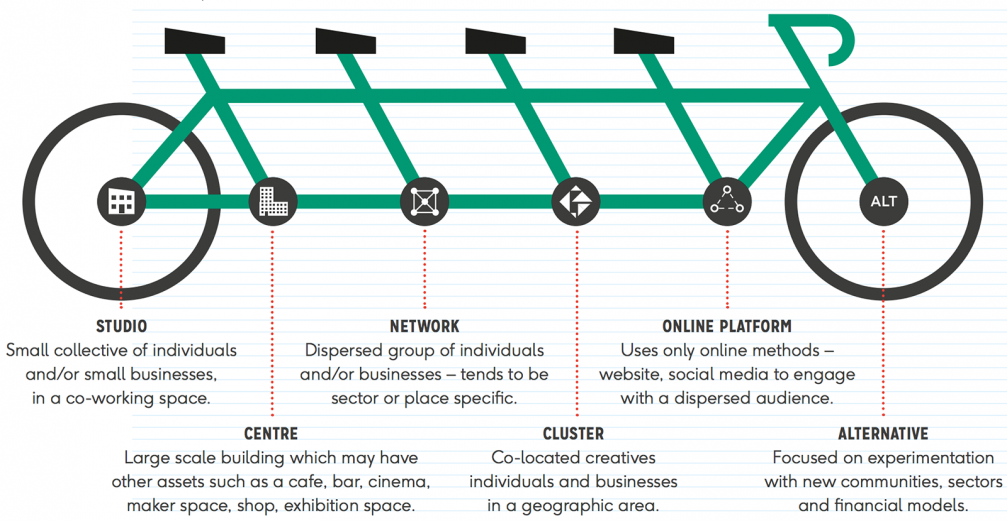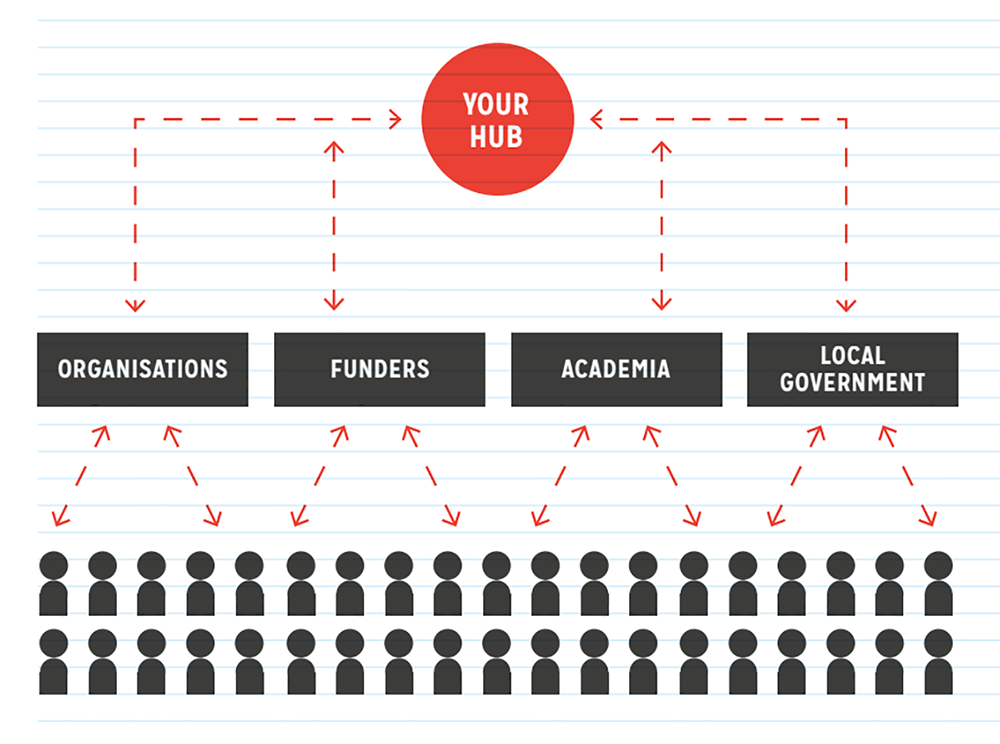Creative Hubs: The Map and The Territory
Published in ATÖLYE Insights · 7 min read · October 11, 2017
Mapping the creative platforms in Istanbul to reveal emerging patterns
Author: engin ayaz, Co-founder & Head of Design, Emre Erbirer, Communications Lead
Creativity in the arts, sciences, design and business used to be perceived mostly as a personal achievement. In fact, the narrative of the 'lone genius' has inspired humankind since the earliest narratives of mythology.
However, in this world of fuzzy logic and messy challenges, the much-adored one-man-show only goes so far. Collaboration across disciplines is an indistinguishable aspect of success in the long term, especially as all activities are increasingly affected by network effects on all fronts.
For networked collaboration to unfold, space and its discontents perform a critical act. This idea of space takes manifold physical and virtual shapes, and can be bundled under the term "hub".
Some creative hubs happen to be solely virtual platforms or aggregators, coalescing the enthusiasm of specific groups around niche issues such as gastronomy, streetscape design, repair culture or biking & women. These hubs remain lean and nimble due to their lack of a permanent, semi-public space, but are able to gather actors and contributors through well-curated events.
Others rely on physical infrastructure which may consist of architectural programs that enable working, learning, prototyping and sharing. These physical hubs are wide-ranging in spatial typology as well, taking a slice of space within industrial heritage buildings, new mixed-use developments, 'old-era' commercial mid-rise building or university campuses. In a way, they become productive parasites within the milieu of the built environment.
Their permanence is both a blessing and a curse, as they can foster a certain community culture through persistence of people and things, while the same 'things' can easily become a liability in a volatile environment.
Globally, these virtual and physical hubs, with their shape-shifting nature, proved to be more 'fungible' than expected, with exponential growth rates over the last decade. There are multiple determinants feeding this growth:
- social media that feeds the culture of 'each person becoming a brand',
- digital fabrication that democratizes pathways for product innovation,
- venture capital and government funding that carves opportunities for high-risk ventures
- and most importantly, the need for feeling connected in an increasingly fragmented and stratified society.
Zooming into Turkey, these determinants are prevalent just as much as the rest of the world. Therefore, it is no surprise that creative hubs are sprouting at a rapid rate, especially in metropolitan areas.

This study was aimed to canvas the terrain of creative hubs in Istanbul only, with the hope that the approach becomes replicable for other cities in Turkey as well. The tough nature of any mapping exercise is the relationship between the map and the territory, in Baudrillardian terms. After all, given the dynamic nature of these social constructs and the relatively turbulent Turkish economics, it is likely that the map will lose its actuality the day it is published.
In fact, just at this moment, a new set of people are probably in the process of establishing a new hub of sorts.
With this in mind, our aim was not to create a static caption of each node in the network, but rather highlight emerging patterns, commonalities and potential collaborations across. Having said that, we hope that you discover your own paths across this terrain and contribute to this discourse; the texture is complex and nuanced.
The Numbers
In this study conducted between December 2016 and March 2017, we have found about 20 virtual hubs that address various niche issues. On the physical front, there are 10 co-working spaces, 29 research centres, 13 maker spaces, 5 fab labs, 10 incubation centres (mostly university-tied), 2 technoparks and 1 living lab across the gamut. Overall, this amounts to about 100 hubs, the majority of which were established in the last 5 years. An amazing feat.
The Stratas among Virtual Hubs
On the virtual hub side, sensitivities to sustainability, urbanism, maker culture and individual entrepreneurship form overarching themes for individual hubs. Under sustainability, problems pertaining to food and transport lead the way. On urbanism, streetscape design and citizen engagement emerge. On maker culture, actors fill different parts of the spectrum, offering alternative paths to mainstream capitalist consumer culture. Finally, more specific hubs are Stage-co with their focus on entrepreneurship and with their diverse set of creative projects with a networked team.
The Stratas among Physical Hubs
Among physical hubs, multiple parameters can be crossed for detecting patterns.
Several districts emerge as key attractors for such hubs, which is not a surprise given their transit accessibility. Outliers are either municipality-connected hubs, or hubs within existing company headquarters. It is natural to expect that more hubs will open in similar peripheral districts across the city.
In terms of sector, academic hubs are on the rise, with both private sector universities opening entrepreneurship-focused hubs, and public universities opening technoparks. Across, the nature of these hubs is more opaque, as the admissions are informed by a structured process, mostly addressing existing students, graduates or specific applicant companies.
Coworking spaces rank high in terms of number and diversity, attracting freelancers, small companies and innovation-focused branches of large companies. Perhaps the key difference among them is their business model focus, as some are scaling rapidly with a real-estate business model at their core, while others remain in one or two locations, and thus focus further on their existing community. ATÖLYE happens to be an outlier because although it does offer a workspace, its focus is more on member interaction and joint projects in a single location.
In terms of makerspaces and Fab Labs, there are various threads. There is a tendency of hubs to focus more on education via workshops, whereas several cater to a small group of specialists, and ATÖLYE's FabLab to a bit wider, but still specialist audience. These hubs are complemented with corporate ventures and niche hobbyist-maker groups.
In terms of research-centric hubs, an emerging bundle is those of Consulates, with French, German, Swedish and Dutch research institutions, coupled with local non-profit engagements.
Finally, niche-group think-tanks also exist, becoming physical manifestations of mission-driven communities around futurism, architecture and ecology.
Funding
Looking across the whole spectrum, it is interesting to note that almost %70 of them are funded either via individual sources, corporations or academic institutions. Meanwhile, the portion funded solely by the government is non-existent. This is a radical finding when compared to the UK, where local councils and the government take a significant role in helping the creative establishments both in their early days as well as for their sustenance.

This resource scarcity in local context has led to interesting, hybrid business models, using local networks to craft bespoke, one-of-a-kind partnerships. Universities are venturing into establishing such hubs in a civic-minded way, fulfilling the role of 'civic libraries' for youthful entrepreneurs to gather and work at no cost. This area of research is certainly a fruitful one, and a more in-depth, cross-cultural study across TIMBI (Turkey, India, Mexico, Brazil, India) could lead to very interesting findings.
Conclusion
This body of work functions as a first approximation on this subject matter. The project does capture a moment in time, fleeting by definition, and it also is inevitably superficial in terms of each hub's mission articulation. We hope that this map invites you to explore the actual territory by connecting with these hubs on your own, and seeing the reality for yourself.
Adapted from the Creative Hubs Mapping project led jointly by ATÖLYE and British Council Turkey, implemented through Graph Commons platform. First published in the Istanbul Creative Hubs Network webpage by the British Council.
What do you think? Please, give us your feedback in the comments section.
